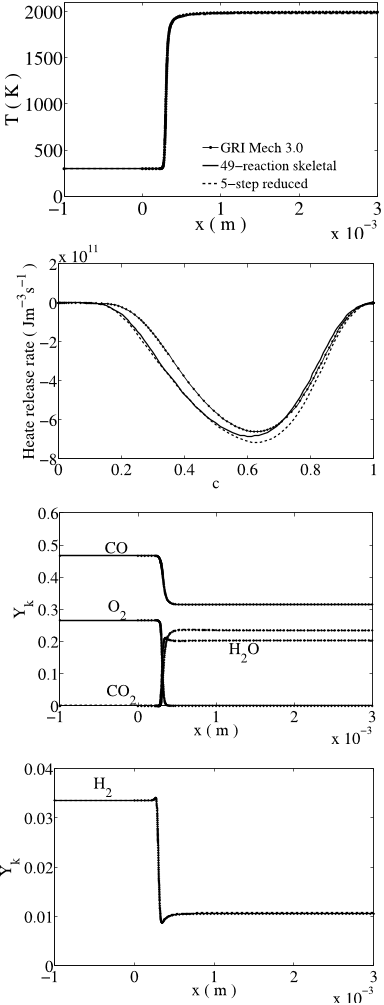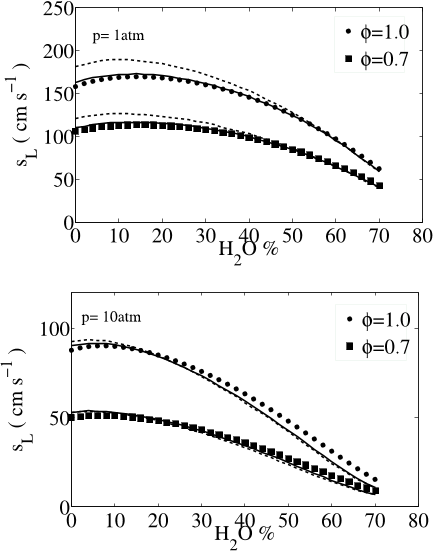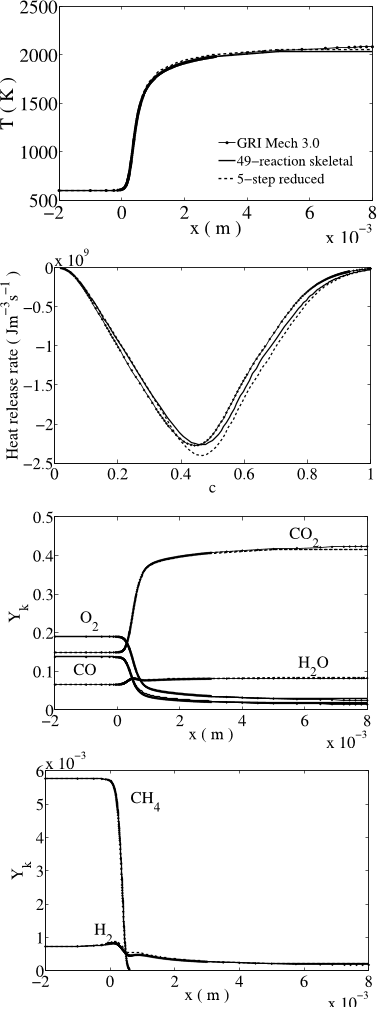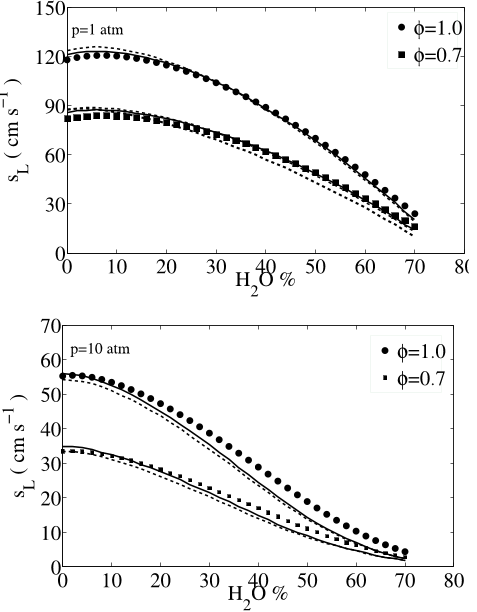Abstract: New experimental profiles of stable species concentrations are reported for formaldehyde oxidation in a variable pressure flow reactor at initial temperatures of 850–950 K and at constant pressures ranging from 1.5 to 6.0 atm. These data, along with other data published in the literature and a previous comprehensive chemical kinetic model for methanol oxidation, are used to hierarchically develop an updated mechanism for CO/H2O/H2/O2, CH2O, and CH3OH oxidation. Important modifications include recent revisions for the hydrogen–oxygen submechanism (Li et al., Int J Chem Kinet 2004, 36, 565), an updated submechanism for methanol reactions, and kinetic and thermochemical parameter modifications based upon recently published information. New rate constant correlations are recommended for CO + OH = CO2 + H (R23) and HCO + M = H + CO + M (R24), motivated by a new identification of the temperatures over which these rate constants most affect laminar flame speed predictions (Zhao et al., Int J Chem Kinet 2005, 37, 282). The new weighted least-squares fit of literature experimental data for (R23) yields k23 = 2.23 × 105T1.89exp(583/T) cm3/mol/s and reflects significantly lower rate constant values at low and intermediate temperatures in comparison to another recently recommended correlation and theoretical predictions. The weighted least-squares fit of literature results for (R24) yields k24 = 4.75 × 1011T0.66exp(−7485/T) cm3/mol/s, which predicts values within uncertainties of both prior and new (Friedrichs et al., Phys Chem Chem Phys 2002, 4, 5778; DeSain et al., Chem Phys Lett 2001, 347, 79) measurements. Use of either of the data correlations reported in Friedrichs et al. (2002) and DeSain et al. (2001) for this reaction significantly degrades laminar flame speed predictions for oxygenated fuels as well as for other hydrocarbons. The present C1/O2 mechanism compares favorably against a wide range of experimental conditions for laminar premixed flame speed, shock tube ignition delay, and flow reactor species time history data at each level of hierarchical development. Very good agreement of the model predictions with all of the experimental measurements is demonstrated. © 2007 Wiley Periodicals, Inc. 39: 109–136, 2007

![Fig. 4: Laminar flame speeds of CO/H2-air mixtures using the reduced (dashed lines) and skeletal (full lines) mechanisms. Symbols: experimental results of Vagelopoulos and Egolfopoulos [48]. Tu = 298 K, p = 1 atm, XN2/XO2 = 3.76.](/figures/fig-4-laminar-flame-speeds-of-co-h2-air-mixtures-using-the-209eopff.png)
![Fig. 3: Laminar flame speeds of syngas mixtures ( CO/H2/CH4/CO2/N2-air ) using the reduced (dashed lines) and the skeletal (full lines) mechanisms. Symbols: experimental results of Yong et al. [27]. fCH4 = 0.24 with 11% CO2 and 42.7% N2 in the fuel mixture. Tu = 298 K, p = 1 atm, XN2/XO2 = 3.76. Error bars from [27] are also shown.](/figures/fig-3-laminar-flame-speeds-of-syngas-mixtures-co-h2-ch4-co2-3u6a11oi.png)


![Fig. 8: Laminar flame speeds of CO/H2 mixtures using the reduced (dashed lines) and skeletal (continuous lines) mechanisms. Symbols: experimental results of Sun et al. [33]. At p = 1 atm the oxidizer is O2,N2 with XN2/XO2 = 3.76. At p = 5, 10, 20 atm the oxidizer is O2 and He with XHe/XO2 = 7.0. Open symbols: experimental results of Singh et al. [21].](/figures/fig-8-laminar-flame-speeds-of-co-h2-mixtures-using-the-1l00yv4j.png)

![Fig. 22: Ignition delay times of CO/H2/CO2/O2/N2 mixtures using the reduced (dashed lines) and skeletal (continuous lines) mechanisms. Symbols: experimental data of [28], 8.91%H2 + 11.58%CO+ 24.44%CO2 + 10.25%O2 + 44.83%N2.62](/figures/fig-22-ignition-delay-times-of-co-h2-co2-o2-n2-mixtures-3pfqzjjf.png)
![Fig. 21: Ignition delay times of CO/H2/O2/N2 mixtures ( XN2/XO2 = 3.76) for φ = 0.5 using the reduced (dashed lines) and skeletal (continuous lines) mechanisms. Symbols: experimental results of Kalitan et al. [55]. Also shown for comparison are the results with the skeletal mechanism of Boivin et al. [14] (dashed lines with ×) for the fH2 = 20/80 case.](/figures/fig-21-ignition-delay-times-of-co-h2-o2-n2-mixtures-xn2-xo2-3newhz2i.png)

![Fig. 1: Laminar flame speeds of CO/H2/H2O-air mixtures using the reduced (dashed lines) and skeletal (full lines) mechanisms. Open circles: Li et al. [31] mechanism results from [22]. Also shown are the predictions using the skeletal mechanism of Boivin et al. (dashed lines with ×) [14]. Filled symbols: experimental results of Das et al. [22]. Tu = 323 K, p = 1 atm, fH2 = 5/95, XN2/XO2 = 3.76.](/figures/fig-1-laminar-flame-speeds-of-co-h2-h2o-air-mixtures-using-1wc6l9to.png)
![Fig. 2: Laminar flame speeds of CO/H2/H2O mixtures using the reduced (dashed lines) and skeletal (continuous lines) mechanisms. Filled symbols: experimental results of Singh et al. [21]. p = 1 atm, Tu = 400 K, φ = 1, oxidiser is O2,N2 with XN2/XO2 = 3.76.](/figures/fig-2-laminar-flame-speeds-of-co-h2-h2o-mixtures-using-the-twgf0oeg.png)
![Fig. 7: Laminar flame speeds of CO/H2/CO2/O2/N2 mixtures using the reduced (dashed lines) and skeletal (continuous lines) mechanisms . Symbols: experimental results of Natarajan et al. [49]. fH2 = 5/95 and 1.0, at p = 1 atm, XN2/XO2 = 3.76 with 10% and 20% CO2 dilution.](/figures/fig-7-laminar-flame-speeds-of-co-h2-co2-o2-n2-mixtures-using-3p13osby.png)
![Fig. 6: Laminar flame speeds of CO/H2 mixtures using the reduced (dashed lines) and skeletal (continuous lines) mechanisms. Filled symbols: experimental results of Singh et al. [21]. p = 1 atm, oxidizer is air.](/figures/fig-6-laminar-flame-speeds-of-co-h2-mixtures-using-the-2hspl2i9.png)




![Fig. 10: Laminar flame speeds of CO/H2/CH4/CO2/O2/N2 mixtures using the reduced (dashed lines) and skeletal (continuous lines) mechanisms. Symbols: experimental results of Park et al. [54], p = 1 atm, Tu = 298 K. 49](/figures/fig-10-laminar-flame-speeds-of-co-h2-ch4-co2-o2-n2-mixtures-1taf19bx.png)

![Fig. 5: Laminar flame speeds of CO/H2/O2/N2 mixtures using the reduced (dashed lines) and skeletal ( continuous lines ) mechanisms. Also shown are the results using the 4- step reduced mechanism of [14] ( open squares ), the skeletal mechanism of [14] ( open circles ) from the same study, and the implementation of the skeletal mechanism of [14] in this study (dashed-dotted lines). Symbols: experimental results of Natarajan et al. [49]. fH2 = 5/95 and 1.0, at p = 1 atm, XN2/XO2 = 3.76, for Tu = 400, 500, 600 and 700 K.](/figures/fig-5-laminar-flame-speeds-of-co-h2-o2-n2-mixtures-using-the-izelzdr2.png)